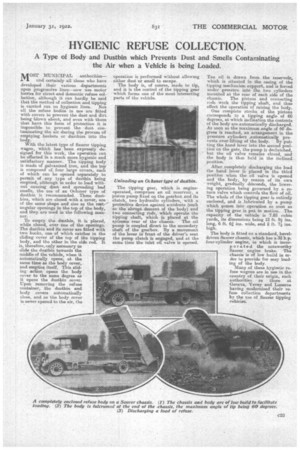HYGIENIC REFUSE COLLECTION.
Page 23

If you've noticed an error in this article please click here to report it so we can fix it.
A Type of Body and Dustbin which Prevents Dust and Smells Contaminating the Air when a Vehicle is being Loaded.
mon AIUNICIPAL authorities— and certainly all those who have developed their various departments upon progressive lines—now use motor lorries for street and domestic refuse collection, although it can hardly be said that the method of collection and tipping is carried out on hygienic lines. Not all the refuse bodies in use are fitted with covers to prevent the dust and dirt being blown about, and even with those that have this form of protection it is impossible, to prevent the dust contaminating the air during the process of emptying baskets or dustbins into the body.
With the latest type of Bearer tipping wagon, which has been expressly &signed for this work, the operation can be effected in a much more hygienic and satisfactory manner. The tipping hi:4y is made of galvanized iron, and the to is composed of, four large covers, each of which can be opened separately to permit of any type of dustbin being emptied, although in order to load without causing dust and spreading bad smells, the use of an Ochsner type of dustbin is recommended. These dustbins, which are closed with a cover, are of the same shape and aize as the rectangular openings in the top of the body, and they are used in the following manner.
To empty the desthin, it is placed, while closed., over one of the openings. The dustbin and its cover are fitted with two hooks, one of which catches in the sliding cover of the top of the tipping body, and the other in the side rod. It is therefore, 'only necessary to slide the dustbin towards the middle of the vehicle, when it automatically opens, at the same time as the body cover, and empties itself. This sliding action opens the body cover to the same degree as it opens the dustbin cover. Upon removing the refuse container, the dustbin and body covers automatically close, and as the body rawer is never opened to the air, the
Operation is performed without allowing either dust or smell to escape. The body is, of course, made to tip, and it is the control of the tipping gear which forms one of the most interesting parts of the vehicle.
The tipping gear, which is engineoperated, comprises an oil reservoir, a piston pump fixed on the gearbox and its clutch, two hydraulic cylinders, with a protective device against accidents (such as the abrupt descent of the body) and two connecting rods, which operate the tipping shaft, which is placed at the extreme rear of the chassis. The oil pump is coupled direct to the secondary shaft of the gearbox. By a movement of the lever in front of the driver's seat the pump clutch is engaged, and at the same time the inlet oil valve is opened.
Tim oil is drawn from the reservoiri, which is situated in the casing of the tipping mechanism support, and is forced under .pressure into the two cylinders mounted at the rear of each side of the
chassis. The pistons and connecting rods work the tipping shaft, and thus effect the operation of raising the body. One complete stroke of the pistons corresponds to a tipping angle of 60 degrees at which inclination the contents of the body are automatically discharged. As soon as the maximum angle of 60 de. grees is reached, an arrangement in the pressure cylinders Automatically prevents over-lifting of the body. By put,z. hug the hand lever into the second position on the gate, the pump is declutched, but the oil valve remains closed, and the body is thus held in the inclined position.
After completely discharging the load the hand lever is placed in the third position when the oil valve is opened and the body; by reason of its own weight, gradually descends, the lowering operation being governed by a return valve which controls the flow of oil. The whole of the tipping gear is entirely enclosed, and is lubricated by a pump which comes into operation so soon as the tipping gear is put in motion. The capacity of the vehicle is 7.85 cubic yards, its dimensions being 12 ft. 9i Ms. long, 6 ft. 62, ins, wide, and 2 ft. 71 ins. high.
The body is fitted on a standard, beveldriven Selmer chassis, which has a 32 h.p. four-cylinder engine, in which is incorporated the noteworthy Sourer engine brake. The chassis is of low build in order to provide for easy loading of the body. Many of these hygienic refuse wagons are in use in the country of their origin, such authorities as those at Geneva, Vevey and Lucerne having modernized their refuse collection departments by the use of Saurer tipping vehicles.




































